Eungyeup Kim
Reliable Test-Time Adaptation via Agreement-on-the-Line
Oct 07, 2023Abstract:Test-time adaptation (TTA) methods aim to improve robustness to distribution shifts by adapting models using unlabeled data from the shifted test distribution. However, there remain unresolved challenges that undermine the reliability of TTA, which include difficulties in evaluating TTA performance, miscalibration after TTA, and unreliable hyperparameter tuning for adaptation. In this work, we make a notable and surprising observation that TTAed models strongly show the agreement-on-the-line phenomenon (Baek et al., 2022) across a wide range of distribution shifts. We find such linear trends occur consistently in a wide range of models adapted with various hyperparameters, and persist in distributions where the phenomenon fails to hold in vanilla models (i.e., before adaptation). We leverage these observations to make TTA methods more reliable in three perspectives: (i) estimating OOD accuracy (without labeled data) to determine when TTA helps and when it hurts, (ii) calibrating TTAed models without label information, and (iii) reliably determining hyperparameters for TTA without any labeled validation data. Through extensive experiments, we demonstrate that various TTA methods can be precisely evaluated, both in terms of their improvements and degradations. Moreover, our proposed methods on unsupervised calibration and hyperparameters tuning for TTA achieve results close to the ones assuming access to ground-truth labels, in terms of both OOD accuracy and calibration error.
BiaSwap: Removing dataset bias with bias-tailored swapping augmentation
Aug 23, 2021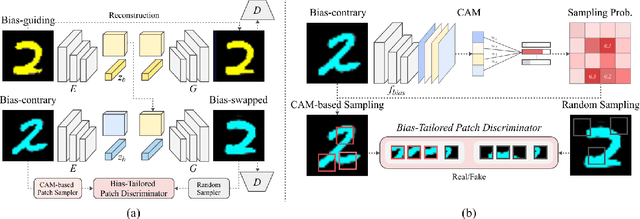
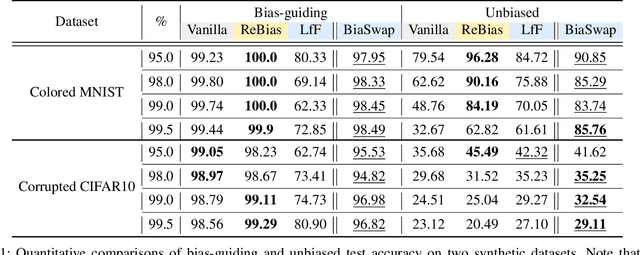
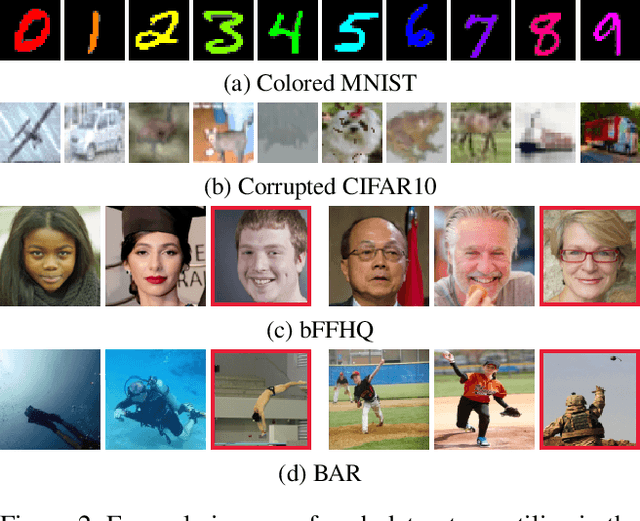
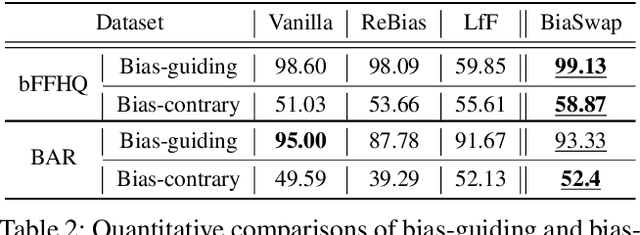
Abstract:Deep neural networks often make decisions based on the spurious correlations inherent in the dataset, failing to generalize in an unbiased data distribution. Although previous approaches pre-define the type of dataset bias to prevent the network from learning it, recognizing the bias type in the real dataset is often prohibitive. This paper proposes a novel bias-tailored augmentation-based approach, BiaSwap, for learning debiased representation without requiring supervision on the bias type. Assuming that the bias corresponds to the easy-to-learn attributes, we sort the training images based on how much a biased classifier can exploits them as shortcut and divide them into bias-guiding and bias-contrary samples in an unsupervised manner. Afterwards, we integrate the style-transferring module of the image translation model with the class activation maps of such biased classifier, which enables to primarily transfer the bias attributes learned by the classifier. Therefore, given the pair of bias-guiding and bias-contrary, BiaSwap generates the bias-swapped image which contains the bias attributes from the bias-contrary images, while preserving bias-irrelevant ones in the bias-guiding images. Given such augmented images, BiaSwap demonstrates the superiority in debiasing against the existing baselines over both synthetic and real-world datasets. Even without careful supervision on the bias, BiaSwap achieves a remarkable performance on both unbiased and bias-guiding samples, implying the improved generalization capability of the model.
Deep Edge-Aware Interactive Colorization against Color-Bleeding Effects
Jul 04, 2021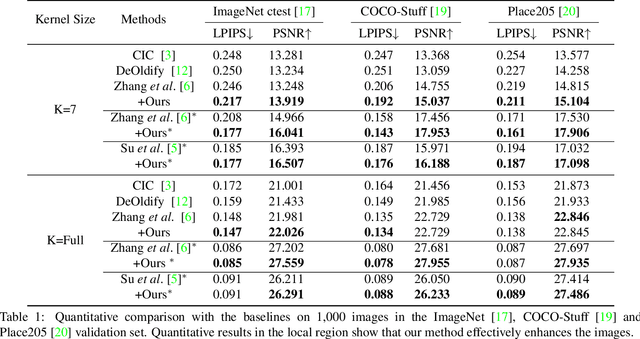
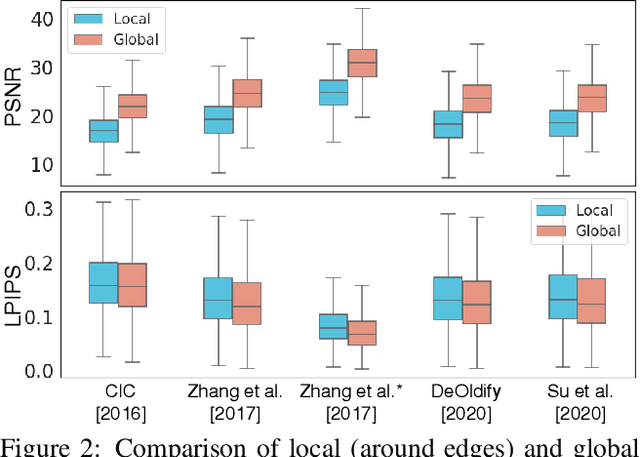
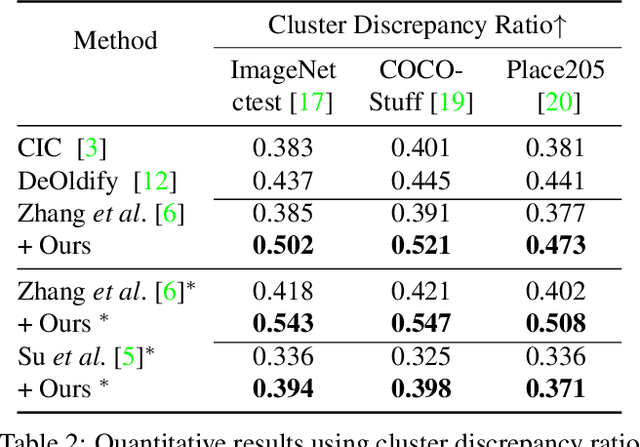
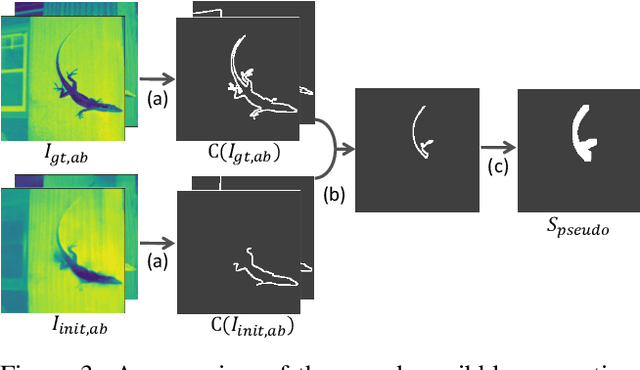
Abstract:Deep image colorization networks often suffer from the color-bleeding artifact, a problematic color spreading near the boundaries between adjacent objects. The color-bleeding artifacts debase the reality of generated outputs, limiting the applicability of colorization models on a practical application. Although previous approaches have tackled this problem in an automatic manner, they often generate imperfect outputs because their enhancements are available only in limited cases, such as having a high contrast of gray-scale value in an input image. Instead, leveraging user interactions would be a promising approach, since it can help the edge correction in the desired regions. In this paper, we propose a novel edge-enhancing framework for the regions of interest, by utilizing user scribbles that indicate where to enhance. Our method requires minimal user effort to obtain satisfactory enhancements. Experimental results on various datasets demonstrate that our interactive approach has outstanding performance in improving color-bleeding artifacts against the existing baselines.
Learning Debiased Representation via Disentangled Feature Augmentation
Jul 03, 2021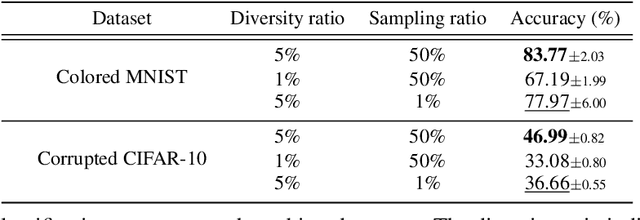
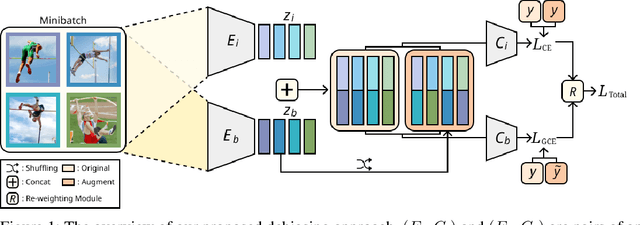
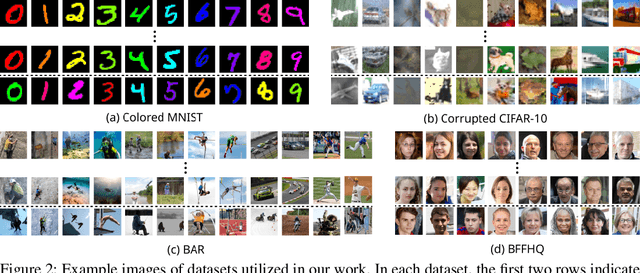
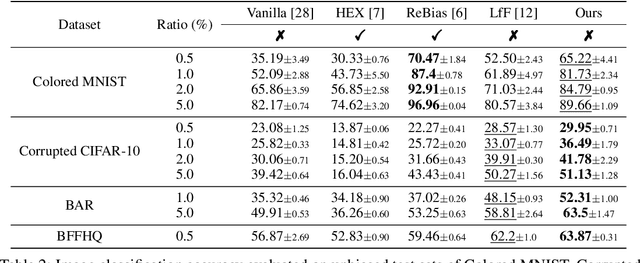
Abstract:Image classification models tend to make decisions based on peripheral attributes of data items that have strong correlation with a target variable (i.e., dataset bias). These biased models suffer from the poor generalization capability when evaluated on unbiased datasets. Existing approaches for debiasing often identify and emphasize those samples with no such correlation (i.e., bias-conflicting) without defining the bias type in advance. However, such bias-conflicting samples are significantly scarce in biased datasets, limiting the debiasing capability of these approaches. This paper first presents an empirical analysis revealing that training with "diverse" bias-conflicting samples beyond a given training set is crucial for debiasing as well as the generalization capability. Based on this observation, we propose a novel feature-level data augmentation technique in order to synthesize diverse bias-conflicting samples. To this end, our method learns the disentangled representation of (1) the intrinsic attributes (i.e., those inherently defining a certain class) and (2) bias attributes (i.e., peripheral attributes causing the bias), from a large number of bias-aligned samples, the bias attributes of which have strong correlation with the target variable. Using the disentangled representation, we synthesize bias-conflicting samples that contain the diverse intrinsic attributes of bias-aligned samples by swapping their latent features. By utilizing these diversified bias-conflicting features during the training, our approach achieves superior classification accuracy and debiasing results against the existing baselines on both synthetic as well as real-world datasets.
Reference-Based Sketch Image Colorization using Augmented-Self Reference and Dense Semantic Correspondence
May 11, 2020



Abstract:This paper tackles the automatic colorization task of a sketch image given an already-colored reference image. Colorizing a sketch image is in high demand in comics, animation, and other content creation applications, but it suffers from information scarcity of a sketch image. To address this, a reference image can render the colorization process in a reliable and user-driven manner. However, it is difficult to prepare for a training data set that has a sufficient amount of semantically meaningful pairs of images as well as the ground truth for a colored image reflecting a given reference (e.g., coloring a sketch of an originally blue car given a reference green car). To tackle this challenge, we propose to utilize the identical image with geometric distortion as a virtual reference, which makes it possible to secure the ground truth for a colored output image. Furthermore, it naturally provides the ground truth for dense semantic correspondence, which we utilize in our internal attention mechanism for color transfer from reference to sketch input. We demonstrate the effectiveness of our approach in various types of sketch image colorization via quantitative as well as qualitative evaluation against existing methods.
Unpaired Image Translation via Adaptive Convolution-based Normalization
Nov 29, 2019

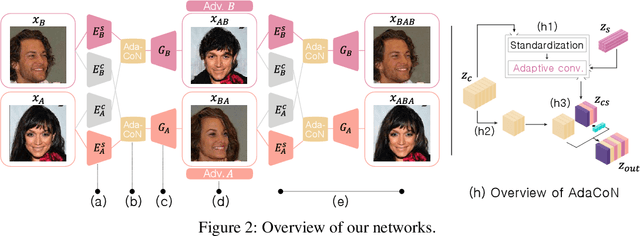
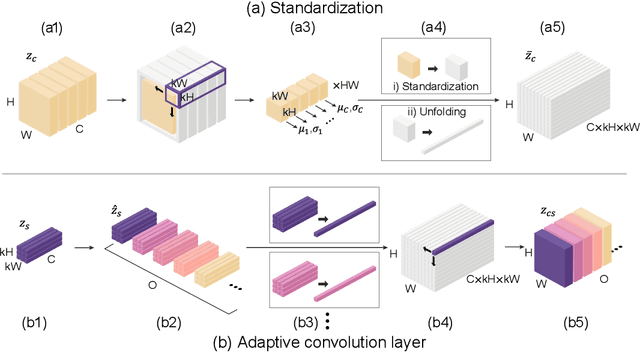
Abstract:Disentangling content and style information of an image has played an important role in recent success in image translation. In this setting, how to inject given style into an input image containing its own content is an important issue, but existing methods followed relatively simple approaches, leaving room for improvement especially when incorporating significant style changes. In response, we propose an advanced normalization technique based on adaptive convolution (AdaCoN), in order to properly impose style information into the content of an input image. In detail, after locally standardizing the content representation in a channel-wise manner, AdaCoN performs adaptive convolution where the convolution filter weights are dynamically estimated using the encoded style representation. The flexibility of AdaCoN can handle complicated image translation tasks involving significant style changes. Our qualitative and quantitative experiments demonstrate the superiority of our proposed method against various existing approaches that inject the style into the content.
 Add to Chrome
Add to Chrome Add to Firefox
Add to Firefox Add to Edge
Add to Edge